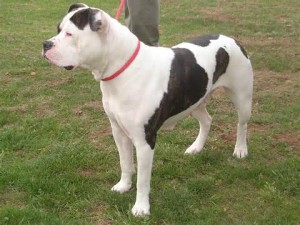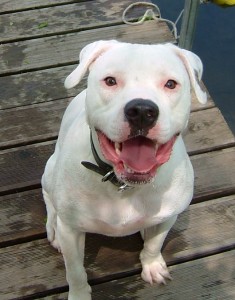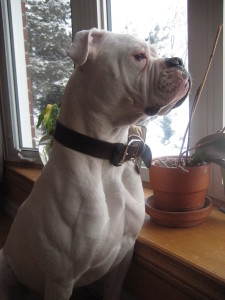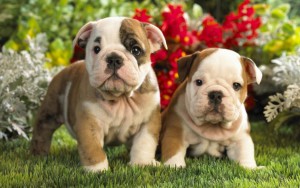The American Bulldog is a breed of working dog. The names associated with the Bully and Standard types are those of the breeders who were influential in developing them, John D. Johnson (Bully) and Alan Scott (Standard).
Appearance
Scott type American Bulldog.
Typical mandibular prognathism is evident.
The American bulldog is a stocky, well built, strong-looking dog, with a large head and a muscular build. Its coat is short and generally smooth. The breed is a light to moderate shedder; however, they should be brushed on regular basis. Colors, while historically predominantly white with patches of red, black, or brindle, have grown in recent years to include many color patterns including black, red, brown, fawn, and all shades of brindle. The color conformation is quite varied, but solid black or any degree of merle is considered a cosmetic fault, and a blue color is a disqualification by the NKC Breed Standard. Black pigmentation on the nose and eye rims is preferred, with only some pink allowed. Eye color is usually brown, but heterochromia also occurs, although considered a cosmetic fault. American Bulldogs can be droolers; this varies and is more prevalent in the Bully type, which is generally a larger, heavier dog with a shorter muzzle. Standard or Performance types are generally more athletic with longer muzzles and a more square head. It is important to note that many modern American Bulldogs are a combination of the two types usually termed "hybrid." In general, American Bulldogs weigh between 27 to 54 kg (60 to 120 lb) and are 52 to 70 cm (20 to 28 in) at the withers, but have been known to greatly exceed these dimensions, especially in the "out of standard," nonworking stock.
Temperament
American Bulldogs are typically confident, social, and active dogs that are at ease with their families. It is not uncommon for an American Bulldog to require a high level of attention due to their highly emotional personality. They bond strongly with their owners. They are capable of jumping in excess of 3 feet (0.91 m) vertical due to the dense muscle build of the breed. Young American Bulldogs may be slightly aloof with strangers, but as they mature the breed's normal confidence should assert itself. This breed tolerates children and can do very well with them, provided they are socialized early and understand their limits. The more exposure to good training practices, other dogs, and people, the more likely the success at being controlled both inside and outside of their environment. Early training and socialization both in the home and outside of the home is essential for this breed. One way to help accomplish this goal can be done in the simplest of ways: walking them regularly at local parks. While the goal of the breed was originally to produce a working farm utility dog that could catch and hold wild boar and cattle, kill vermin, and guard an owner's property, when properly trained, exercised and socialized, this breed can become a great family pet.
History
History in Spain and England
Even the slight modifications the bulldog underwent in Spain and England up to the Industrial Revolution (before 1835), were absent in the working strains. Most settlers of the American South came from the West Midlands of England and emigrated as a result of the Civil War between Royalists and Parliamentarians, well before the Industrial Revolution).
History in the United States
The Old English Bulldog was preserved by working class immigrants who brought their working dogs with them to the American South. Small farmers and ranchers used this all-around working dog for many tasks including farm guardians, stock dogs and catch dog. These dogs were not an actual breed as considered by today's standards but were a generic bulldog type. There were no recorded pedigrees or records and breeding decisions were dependent on the best working farm dogs despite breed or background. Several separate strains of the "bulldog" type dogs were kept by ranchers as utilitarian working dogs.
Perhaps the most important role of the bulldog and the reason for its survival, and in fact why it thrived throughout the South, was because of the presence of feral pigs, introduced to the New World and without predators. The bulldogs were the settlers' only means of sufficiently dealing with the vermin. By World War II, the breed was near extinction until John D. Johnson and his father scoured the back roads of the South looking for the best specimens to revive the breed. During this time a young Alan Scott grew an interest in Johnson's dogs and began to work with him on the revitalization process. At some point, Alan Scott began infusing non-Johnson catch bulldogs from working Southern farms with John D. Johnson's line, creating the now Standard American Bulldog. At another point, Johnson began crossing his line with an atavistic English bulldog from the North that had maintained its genetic athletic vigor.
Health
American Bulldogs generally live from 10 to 16 years, and tend to be strong, physically active, and often healthy. Some health problems in American bulldogs are often found within certain genetic lines, and are not common to the entire breed, while others, such as neuronal ceroid lipofuscinosis (NCL), Ichthyosis, disorders of the kidney and thyroid, ACL tears, hip dysplasia, cherry eye, elbow dysplasia, entropion, ectropion, and bone cancer are more common to the general population of American Bulldogs. There are DNA tests available to help breeders screen breeding animals for NCL (neuronal ceroid lipofuscinosis)[1] and Ichthyosis. It is highly recommended to spend time to research your breeder information, including your American Bulldog's family history. A Penn Hip (Pennsylvania Hip Improvement project) or OFA (Orthopedic Foundation for Animals) screening is recommended for all potential breeding animals. Some breeds of American Bulldog are prone to allergies. Symptoms like a runny nose or a rash are examples of signs of allergies. Some vets recommend dog owners to give 25 mg of Benadryl per day; in most cases it helps




